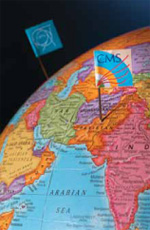LHC detector project a big leap for Pakistan

Photo: Reidar Hahn, Fermilab
For most scientists, membership in a Large Hadron Collider experiment is a ticket to research at a frontier of particle physics. For Hafeez Hoorani, it also marked his country’s first step toward building a tradition of experimental particle physics research.
Hoorani is director of research for Pakistan’s National Center for Physics, Quaid-i-Azam Campus. When he joined the Large Hadron Collider’s CMS experiment in 1994, Pakistan had a long tradition in theoretical particle physics but had not collaborated on experiments in the field.
Because it lacked facilities and experience in constructing sophisticated particle detectors, at first it was unclear what Pakistan could offer CMS.
Yet Hoorani’s group would go on to build a critical component of the experiment’s muon detection system. The resistive plate chambers, or RPCs, record the precise times that muons and other particles pass through the muon detector. They help determine which data from the detector are stored for future study. And their construction played a pivotal role in establishing a new direction for particle physics research in Pakistan.
The chambers were assembled at the National Center for Physics from parts made by Pakistani companies, and tested there for performance and quality. The project cost US$2.5 million, a significant investment for the country. It led to the training of about 50 young scientists and engineers.
"We needed to build 320 chambers of the size used in CMS, which required a big engineering enterprise that I had to set up from scratch," Hoorani recalls. "This brought something very new to Pakistan—the concept of quality assurance in building detectors."
The path to participation in CMS hasn't been easy, and Hoorani’s 30-member research group still struggles to get funding for research, travel, and computing. Despite these difficulties, the group has eagerly begun searching for the Higgs boson among the very first high-energy collision data from the CMS detector.
Katie Yurkewicz
Click here to download the pdf version of this article.






